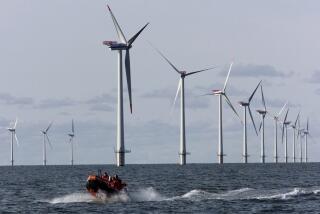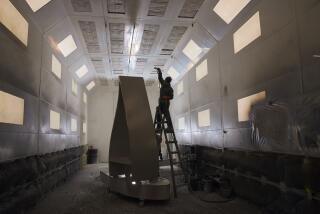Too few farmers to harvest the winds
- Share via
LINCOLN, KAN. — The line of towering wind turbines stands motionless on the ridgeline above Interstate 70 in central Kansas, Y-shaped silhouettes amid the swirling snow.
Despite the weather, dozens of technicians are working to get the 10-mile-long Smoky Hills Wind Farm ready to begin producing electricity.
Jason Martinson, who is supervising the 56-turbine operation for Enel North America Inc., said that after almost a decade in the industry he’s still amazed by how fast wind farms like Smoky Hills are going up across the country. But he also said workers such as those braving the blizzard-like conditions outside his office were becoming increasingly rare.
“Finding experienced techs is impossible with wind growing as fast as it is,” Martinson said. “You get one year’s worth of experience, and it’s like dog years.”
Considered a cheap source of renewable power, wind farms have taken off amid concerns over greenhouse gases produced by coal-fired electric plants and the increasing cost of natural gas and other petroleum products. Some states have encouraged their development by requiring that a certain portion of their future energy be created through renewable resources.
Last year, wind farms installed almost 3,200 turbines, boosting the nation’s wind energy capacity by 45% and cranking out an additional 5,200 megawatts, or enough electricity to power 1.5 million homes for a year. The industry, which now accounts for a little more than 1% of the U.S. electric supply, expects to repeat that surge in 2008.
Critics of wind power have called the mammoth turbines eyesores and environmentalists have fought against them, warning that the giant rotors could pose a hazard to migratory birds and other wildlife.
But wind power officials see a much larger obstacle coming from its workforce, a highly specialized group of technicians that combines working knowledge of mechanics, hydraulics, computers and meteorology with the willingness to climb 200 feet in the air in all kinds of weather.
That workforce isn’t keeping up with the future demand, partly because the industry is so new that the oldest independent training programs are less than 5 years old.
The American Wind Energy Assn., a Washington-based trade group, estimates the industry employs about 20,000 people, not including those making turbines or other equipment.
Future need is harder to quantify, given the uncertainties of the industry’s growth. But with two-man teams generally responsible for seven to 10 turbines, the industry would need as many as 800 technicians to serve the turbines expected to be installed this year.
Park developers, turbine manufacturers and utilities are investing in training programs, attempting to lure workers with wages of as much as $25 an hour, or teaming up with the growing number of training programs being offered at community and technical colleges.
At Columbia Gorge Community College in the Dalles, Ore., seven wind companies are working with the school as academic advisors. Several of the companies are also supporting the college financially, including a three-year, $150,000 grant from Portland, Ore.-based PPM Energy Inc. and donated equipment from Arlington, Va.-based AES Corp.
“They are all just crammed to the gills with students,” said Jeremy Norton, training manager for PPM.
The industry tends to draw heavily from the military and from agricultural areas, which put a heavy emphasis on machinery and technical training. In Oregon, which ranks seventh in the nation for wind generation, many wind farms have taken advantage of the need for jobs and training left behind in some towns where aluminum mills closed years ago.
“We’re accepting a lot of people with technical skills that don’t have wind experience,” said Norton, whose utility fills out the employee’s skills with its own training. “But if you have technical skills and wind experience, you can pretty much write your own ticket in the industry and go anywhere you want to go.”
That’s what attracted Matt Froese, 19, who just started the wind energy program at Cloud County Community College in Concordia, Kan. He said he hadn’t heard of wind energy until an uncle who is leasing land for some wind turbines showed him some pictures.
“It’s a career that has a good future in it, and it’ll help the environment because it doesn’t pollute,” Froese said. “I figured there’d be a lot of job opportunities when I graduated.”
On the first day of school at Columbia Gorge, a wind company representative came to talk to the class, and two students left to take jobs that afternoon.
“We’ve told [the companies] since that day, no more,” said instructor Tom Lieurance. “We are going to wait till spring before I let any more hungry lions in to get my students.”
Antonio Coutinho, chief energy management officer for wind farm developer Horizon Energy, said training would become more important as the turbine technology became more complex. The industry has no choice but to get its message out and attract the best candidates, he said.
“The growth is going to continue,” Coutinho said. “In every system, every market, supply always meets demand sooner or later.”
More to Read
Sign up for Essential California
The most important California stories and recommendations in your inbox every morning.
You may occasionally receive promotional content from the Los Angeles Times.













